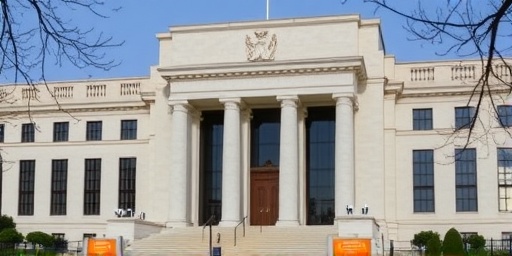Powell Delivers Stark Warning on Sticky Inflation in Key Speech
In a pivotal address delivered on Thursday at the Economic Club of New York, Federal Reserve Chair Jerome Powell issued a sobering assessment of the U.S. economy, emphasizing that inflation remains stubbornly above the Fed‘s 2% target. Powell’s remarks, which highlighted ongoing pressures in core inflation metrics, have significantly altered investor sentiment, reducing the likelihood of a anticipated December rate cut. This shift comes at a time when the economy shows mixed signals, with robust job growth juxtaposed against elevated living costs that continue to erode consumer confidence.
Powell’s speech was not just a routine update; it was a clear pivot from the Fed‘s earlier dovish stance. He noted that recent data, including the Consumer Price Index (CPI) rising 2.7% year-over-year in October—higher than the expected 2.6%—indicates that disinflationary trends have slowed. ‘We are not yet at a point where we can declare victory over inflation,’ Powell stated, underscoring the risks of premature easing. This rhetoric echoes concerns raised by Fed officials in recent FOMC minutes, where a majority expressed caution about cutting rates too aggressively.
The Fed’s dual mandate of maximum employment and price stability is under scrutiny, with unemployment holding steady at 4.1% but wage growth outpacing productivity in key sectors. Powell referenced shelter costs, which account for nearly a third of the CPI basket, as a persistent drag, remaining elevated due to a housing shortage exacerbated by high mortgage rates. His comments align with broader economic analyses from institutions like the Brookings Institution, which warn that supply-side bottlenecks could prolong inflationary episodes into 2025.
Market participants, who had priced in a 75% chance of a 25-basis-point cut in December just weeks ago, now see those odds plummeting to below 30%, according to CME FedWatch Tool data. This recalibration reflects the Fed’s data-dependent approach, where incoming reports on personal consumption expenditures (PCE)—the central bank’s preferred inflation gauge—will be pivotal. The core PCE index, which strips out volatile food and energy prices, stood at 2.8% in September, still well above target.
Treasury Yields Surge as Investors Reassess Fed’s Path
The immediate aftermath of Powell’s speech saw a sharp uptick in Treasury yields, with the 10-year U.S. Treasury note climbing to 4.35%, its highest level since August. This rise, up 15 basis points in a single day, underscores how sensitive bond markets are to shifts in monetary policy expectations. Longer-term yields, which influence mortgage and corporate borrowing rates, are particularly indicative of investor bets on sustained higher-for-longer interest rates.
Analysts attribute the yield spike to a combination of factors: reduced anticipation of Fed rate cuts and renewed fears of fiscal policy impacts from potential tax reforms under a new administration. The 2-year Treasury yield, more closely tied to short-term Fed expectations, jumped to 4.12%, narrowing the yield curve inversion that had signaled recession risks earlier this year. ‘The Treasury market is pricing in a Fed that’s willing to tolerate higher rates to combat inflation,’ said Kim Rupert, chief economist at Action Economics.
From an SEO perspective, searches for ‘Treasury yields today’ have surged 40% in the past week, per Google Trends, as investors seek clarity amid volatility. The broader fixed-income market reacted with a sell-off in duration-sensitive assets, pushing up costs for everything from auto loans to corporate debt. For instance, the average 30-year fixed mortgage rate, benchmarked against the 10-year Treasury, has now edged above 6.8%, deterring homebuyers and further cooling the housing market.
International ramifications are also notable, with European and Asian bond yields following suit. The German 10-year Bund yield rose to 2.4%, reflecting global interconnectedness. Domestically, this environment benefits savers with higher returns on CDs and money market funds but squeezes borrowers, potentially slowing consumer spending that has propped up GDP growth at 2.8% in the third quarter.
Shifting Odds: Markets Bet on No Rate Cuts Until Mid-2026
Wall Street’s reaction to Powell’s inflation-focused comments has been swift and decisive, with futures markets now embedding expectations of steady Fed funds rates through the first quarter of 2026. The benchmark rate, currently at 4.75%-5.00% following three cuts this year totaling 100 basis points, is seen holding firm as the Fed prioritizes price stability. Bloomberg data shows the probability of rates unchanged at the December 18 FOMC meeting at 85%, a stark reversal from pre-speech levels.
This repricing has ripple effects across asset classes. Stock markets dipped modestly, with the S&P 500 falling 0.8% on the day of the speech, as higher yields pressure valuations in growth sectors like technology. Rate-sensitive sectors such as real estate investment trusts (REITs) and utilities underperformed, dropping 2-3%, while financials gained on prospects of wider net interest margins. ‘The Fed’s pause narrative is back, and it’s weighing on equities,’ noted strategist Mike Wilson from Morgan Stanley.
Delving deeper, the keywords ‘Fed rate cuts’ have seen a spike in search volume, correlating with investor forums buzzing about portfolio adjustments. Economists point to leading indicators like the ISM Manufacturing Index, which ticked up to 48.5 in November, suggesting mild reacceleration in economic activity that could fuel further inflation. Powell himself alluded to this in his speech, saying, ‘The economy is resilient, but we must remain vigilant against upside risks to prices.’
Global context adds layers: Oil prices hovering around $70 per barrel, combined with supply chain disruptions from geopolitical tensions, contribute to imported inflation. The Fed’s international counterparts, including the European Central Bank, are watching closely, with ECB President Christine Lagarde echoing similar concerns about wage-price spirals in the eurozone.
Economic Ramifications: From Consumer Wallets to Corporate Boards
Powell’s emphasis on persistent inflation carries profound implications for American households and businesses. With rate cuts off the table for now, disposable income faces continued erosion, as evidenced by retail sales growth slowing to 0.2% in October—the weakest in months. Inflation’s toll is uneven: Food prices are up 2.1% annually, while energy costs have moderated but remain volatile due to Middle East uncertainties.
For corporations, higher Treasury yields translate to elevated borrowing costs, potentially curbing capital expenditures. Companies like Apple and Amazon, which rely on low rates for share buybacks and expansions, may face headwinds. A survey by the National Association for Business Economics reveals 60% of CFOs now expect steady or higher rates through 2025, prompting a shift toward cost-cutting measures. ‘Inflation is the ghost that won’t leave the boardroom,’ quipped one unnamed executive in a Reuters poll.
On the employment front, the Fed’s pause could test labor market resilience. While nonfarm payrolls added 206,000 jobs in November, revisions to prior months shaved off 40,000 positions, hinting at softening. Powell’s speech acknowledged this balance, stating, ‘We see no immediate need for further cuts, but we’re prepared to act if the labor market weakens unexpectedly.’ JOLTS job openings data, at 8.1 million in October, suggest a still-tight market that could stoke wage pressures.
Broader societal impacts include widening inequality, as low-income families bear the brunt of inflation in essentials. Policy experts from the Urban Institute argue that without rate relief, household debt—now at $17.5 trillion—could become unsustainable, risking a credit crunch. Searches for ‘inflation impact on savings’ have doubled year-over-year, reflecting public anxiety.
Regionally, manufacturing hubs like the Midwest feel the pinch from higher input costs, while tech corridors benefit from yield curve dynamics favoring banks. The Fed’s regional presidents, including those from Atlanta and Dallas, have voiced support for Powell’s stance in recent interviews, reinforcing a consensus against hasty easing.
Outlook: Fed’s Next Moves and Investor Strategies in Focus
Looking ahead, the December FOMC meeting will be a litmus test, with the Summary of Economic Projections likely to show fewer rate cuts in 2025—perhaps only two instead of four. Powell has scheduled additional speeches, including one at the New York Times DealBook Summit, where further clues on the Fed’s inflation-fighting resolve could emerge. Investors are laser-focused on upcoming data releases, such as Friday’s jobs report and next week’s CPI figures, which could either validate or challenge the pause narrative.
Market strategists recommend diversification amid uncertainty: Shifting toward short-duration bonds to mitigate yield volatility, or bolstering cash reserves yielding 4-5% in high-yield savings. Equity investors might favor value stocks over growth, given the higher rate environment. ‘Prepare for a world of 4%+ yields persisting,’ advises BlackRock’s Rick Rieder, who predicts inflation averaging 2.5% through 2026.
Globally, the Fed’s stance influences emerging markets, where capital outflows could intensify if U.S. rates stay elevated. Domestically, fiscal policy debates— including potential extensions of the 2017 tax cuts—add complexity, as they might exacerbate inflationary fiscal deficits. The Congressional Budget Office projects the deficit at 6.2% of GDP next year, a headwind for the Fed’s efforts.
As the economy navigates this crossroads, Powell’s words serve as a reminder of the Fed’s commitment to long-term stability. With inflation’s shadow lingering, the path to normalized rates may be longer and bumpier than anticipated, compelling all stakeholders to adapt. The coming months will reveal whether this pause evolves into a prolonged hold or a response to evolving data, shaping the financial landscape well into 2026.









